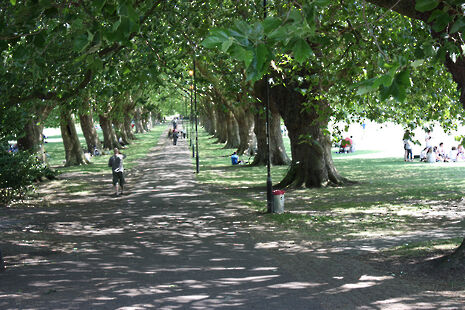In search of greener pastures…
Cambridge holds the second highest intensity of conservation projects in the world. But where are they? Sam Hunt explores the University’s green scene

On November 26th, the United Nations Climate Negotiations will begin in Qatar; an event which also coincides with the 4th anniversary of the UK’s Climate Change Act. Before the end of the negotiations on December 7th, our government will have to make key decisions that will either support or undermine their commitment to hitting our country’s carbon budget next year.
This all seems very distant from the average debt-ridden Cambridge student: Qatar lies over 3000 miles from our shores, and government policy frequently feels an equally unreachable distance away from our opinions. However, as Matthew Williams – Climate Officer at RSPB and co-director of the UK Youth Climate Coalition – explains, these international negotiations will play a larger role than meets the eye. The Conference of Youth will take place before the discussions, bringing teenagers and young adults from across the globe to operate alongside the Conference of the Parties and take part in their own negotiations as a cohesive youth stakeholder group.
Whether they are able to achieve policy change or not, Williams argues that their presence creates pressure, a reminder to those at the conference of their responsibility to the youth of the future. Last year, amidst the series of other similar protests around the world, youth delegates formed ‘Occupy the COP’ outside the various conference rooms as a means of voicing the youth opinion on climate and sustainable development.
Williams argues for the expanding worldwide ambition of the Conference of Youth: “A really exciting thing just happened in the past few weeks: the Arab Youth Climate Movement has set themselves up in time for Qatar, I suppose on the back of the wave of the Arab Spring. It’s something that, certainly in the UK and the US, people in the climate movement are very excited by.”
In the midst of all of this international innovation surrounding climate and sustainability issues, we turn to consider the Cambridge green scene. Am I simply ignorant to the green amongst the Cambridge blue, or is there a notable absence of well-advertised movements which work towards a more sustainable university? According to Emily Dunning – the current manager of Cambridge Hub – much more is happening in the Cambridge green scene than is immediately visible.Cambridge contains the second highest intensity of conservation organisations – of both local and university origin – in the world, second only to Washington D.C. Cambridge Carbon Footprint, Zero Carbon, Responding to Climate Change, 4CMR and Transition Cambridge form just the tip of the iceberg that Dunning explains to me. The Cambridge Hub is itself a national network working in eight different universities, supporting students campaigning for ethical issues, social enterprise and sustainability.
As we discuss the subject of the Qatar negotiations and their prospective achievements, Dunning argues instead that action is all about locality: “we can’t wait for top-down stuff to happen; we’ve got to make this happen”.
The national is formed by the accumulation of the local, and with Cambridge standing as an insitution of progress and inspiration, movement towards sustainability needs to happen here, on a student level, as efforts combine to work towards reaching the nation’s energy budget.
However, only in the last year has the University, as an internationally renowned locality, started taking its own sustainability seriously. Cambridge seems to have caught onto the nation’s carbon budgets quite late in the game. The Living Laboratory for Sustainability works to improve the environmental strategic planning on the University estate by working with and funding anyone who has ideas for progression. It has been in the works since 2010 and yet has only been officially rolled out as a working project over the past few months.
Isobel Braithwaite and Daisy Haywood formed Energise Cambridge last year after becoming aware of the University’s stagnation in moving towards alternate fuel sources. Energise Cambridge aims to persuade the University to commit to an ambitious target for more funding for renewable energy and to engage Cambridge students on issues of climate change.
The campaign stated in its Windmill campaign video from last year’s Parker’s Piece protest: “Of the 237 respondents to Energise Cambridge’s survey of Cambridge students so far, 90.3% would be prepared to pay an extra £10 per year in university fees to help fund the purchase of renewable energy.” Braithwaite agrees that the windmill protest was visually interesting, but that more is needed to get the University to change its policies. She strongly advocates the need for greater leadership and larger student support if anything further is to be achieved.
What about the idea of a taught concept of sustainability? Braithwaite argues that education should be naturally inclusive of subject-related sustainability, so that no one can turn around and claim “It’s not my subject: it’s not my issue”. Educational institutes such as Australia’s Monash University and the University of the UN (UNU) both claim to be at the origins of a new type of instructive progress. The latter, founded in 1969 and now based in 13 different countries, states its aims:

“The overarching goal of the United Nations University is to contribute to global sustainable development that will enable present generations to live a decent life in peace, in freedom, in safety, and in good health without compromising the ability of future generations to do the same.”
Cambridge University may have signed the Cambridge Climate Change Charter in 2007, but it is still debateable whether actual change is being initiated. Dunning argues for progress: in the past year of her employment with the Hub, the organisation has seen more fight than ever for the cause.
However, like Braithwaite, Dunning still searches for a call to arms – the green way. Even if we aren’t flying out to Qatar to argue for the success of international carbon budgets, we need a means of working on that precious local level.
Dunning suggests that it is the societies, rather than the students, who need to put in a little more energy: they need to increase and enforce more advertising and publicity: “the thing that people don’t crack, people who are interested in environmental issues, is how to get it out to a wider audience, to get people engaged who aren’t necessarily engaged already.”
If Cambridge is greener than we initially perceived, then the green needs to shine with lurid and inescapable vividness, rather than move beneath the visible surface. Students are massing together both locally and nationally to consider how sustainability can be achieved for future generations, we can only hope that the older generation of policy makers are listening.
 News / Clare Hall spent over £500k opposing busway 24 December 2025
News / Clare Hall spent over £500k opposing busway 24 December 2025 Comment / The ‘class’ of Cambridge24 December 2025
Comment / The ‘class’ of Cambridge24 December 2025 News / Caius mourns its tree-mendous loss23 December 2025
News / Caius mourns its tree-mendous loss23 December 2025 Comment / League tables do more harm than good26 December 2025
Comment / League tables do more harm than good26 December 2025 News / Girton JCR publishes open letter expressing solidarity with Palestine25 December 2025
News / Girton JCR publishes open letter expressing solidarity with Palestine25 December 2025








